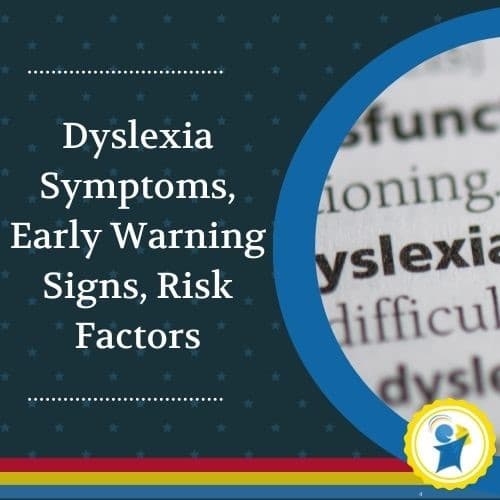
We discuss seven of the most common symptoms of dyslexia and four warning signs that a young child may be at risk of dyslexia. Signs of dyslexia can be difficult to recognize before a child enters school, but some early clues may indicate a problem. We also look at three risk factors. Risk factors increase the chance of developing a disease, disorder, or condition. Lastly, we consider ways to overcome the symptoms.
.
Table of contents:
- Introduction
- What is dyslexia?
- What are the symptoms of dyslexia?
- What are the early warning signs of dyslexia?
- What are the risk factors for dyslexia?
- Overcoming the symptoms of dyslexia
Introduction
Most children starting school look forward to learning to read and, in fact, do so quickly. For children with dyslexia, however, the experience is very different.
For them, letters and words that seem to come effortlessly for everyone else, appear to be beyond their grasp. The process whereby they learn to transform what are essentially abstract squiggles on a page into meaningful letters, then sounds, then words, and then entire sentences and paragraphs seem to be an impossible task.
They are slow to learn to decode words and become fluent; they also struggle to generalize and read novel words they have never seen before. Words they read correctly in one sentence may be misread in a subsequent sentence. Reading aloud may be particularly painful.
What is dyslexia?
Dyslexia is a learning disorder that affects the ability to read, spell, and write. People with dyslexia are often smart and hardworking but have trouble connecting the letters they see to the sounds those letters make.
Dyslexia is the most common learning disability, affecting children across languages, writing systems, and educational approaches.
The most widely cited definition of dyslexia states that “[Dyslexia is] a disorder manifested by difficulty in learning to read despite conventional instruction, adequate intelligence, and sociocultural opportunity. It is dependent upon fundamental cognitive disabilities, which are frequently of constitutional origin” (Snowling, 2000).
Children with learning disabilities may start to resent school. It is, therefore, important that parents and teachers alike know the signs and symptoms of dyslexia so that they can intervene.
What are the symptoms of dyslexia?
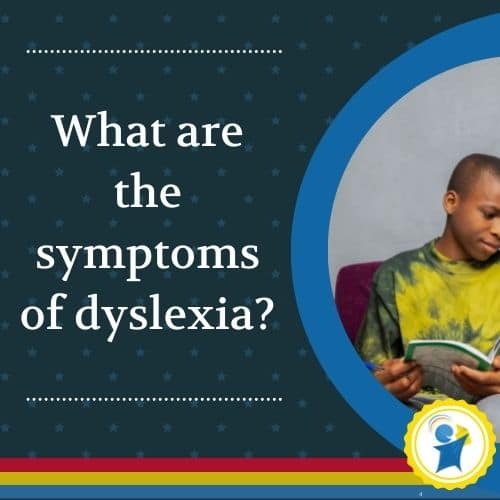
Symptoms of dyslexia usually become clear when children start school and begin to focus on learning to read and write. The child’s teacher may be the first to notice a problem.
Symptoms of dyslexia include:
Weakness in phonological processing
The term “phonological” comes from the Greek word phone, which means “sound.” Phonological processing refers to the use of phonological information — especially the sound structure of one’s oral language — to process written language (i.e., reading, writing) and oral language (i.e., listening, speaking).
Symptoms of dyslexia that indicate difficulty in phonological processing include:
- A struggle to decode words, which is the ability to match letters to sounds.
- Inability to rapidly retrieve letter sounds while analyzing words so that the beginning of the word is already forgotten by the time the last letter of the word is recalled.
- Children with dyslexia may find it difficult to blend individual sounds into words; they may sound out the letters of the word correctly but then be unable to say the correct word. For example, they may sound the letters ‘c-a-t’ but then says cold.
- Vowel sounds are particularly troublesome.
.
Poor reading fluency
Fluency is the ability to read “as you speak.” Hudson et al. define fluency as follows:
Reading fluency comprises at least three key elements: accurate reading of a text at a conversational rate with appropriate prosody or expression.
Nonfluent readers suffer in at least one of these aspects of reading: they make many mistakes, read slowly, or do not read with appropriate expression and phrasing.
Decades of research indicate that fluency is one of the critical building blocks of reading because fluency development is directly related to comprehension. Below are the results of one study by Fuchs et al. that shows how oral reading fluency correlates highly with reading comprehension.
| Measure | Validity Coefficients |
|---|---|
| Oral Recall/Retelling | .70 |
| Cloze (fill in the blank) | .72 |
| Question Answering | .82 |
| Oral Reading Fluency | .91 |
To interpret the correlation data, consider that a perfect match would be 1.0. As one can see, oral recall/retelling, fill-in-the-blank, and question answering are all above 0.6, indicating a strong correlation. Oral reading fluency is by far the strongest, with a .91 correlation.
Directional confusion
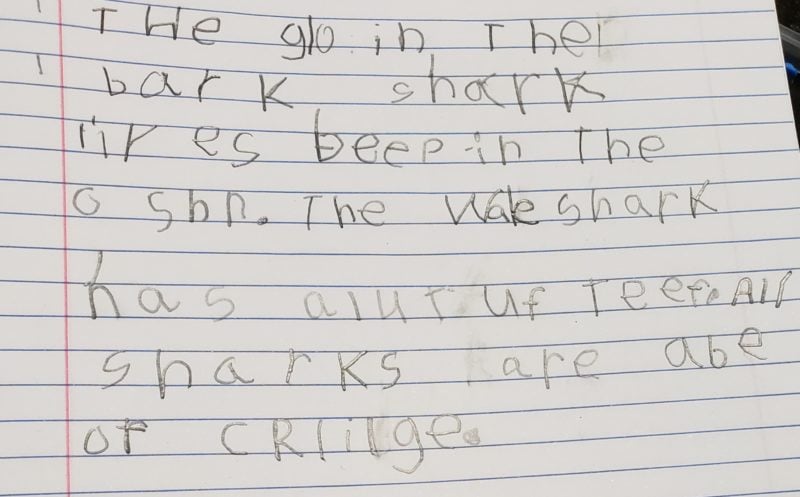
Directional confusion may take several forms, from being uncertain of which is left and right to being unable to read a map accurately.
Directional confusion is the reason for reversing letters, whole words, numbers, and mirror writing. The following symptoms indicate directional confusion:
- Children with dyslexia may reverse letters like b and d, or p and q when reading or writing.
- They may invert letters, reading or writing n as u, m as w, d as q, p as b, f as t.
- They may read or write words like on for on, tar for rat, now for won, was for saw.
- They may read or write 71 for 17.
.

Sequencing difficulties
Sequencing refers to our ability to perceive items in a specific order and remember that sequence.
Many people with dyslexia have trouble with sequencing. Naturally, this will affect their ability to read and spell correctly. After all, every word consists of letters in a specific sequence. To read, one needs to perceive the letters in sequence and remember the word represented by the sequence of letters in question. Simply changing the sequence of the letters in name it can become mean or amen.
The following are a few of the dyslexia symptoms that indicate a difficulty with sequencing:
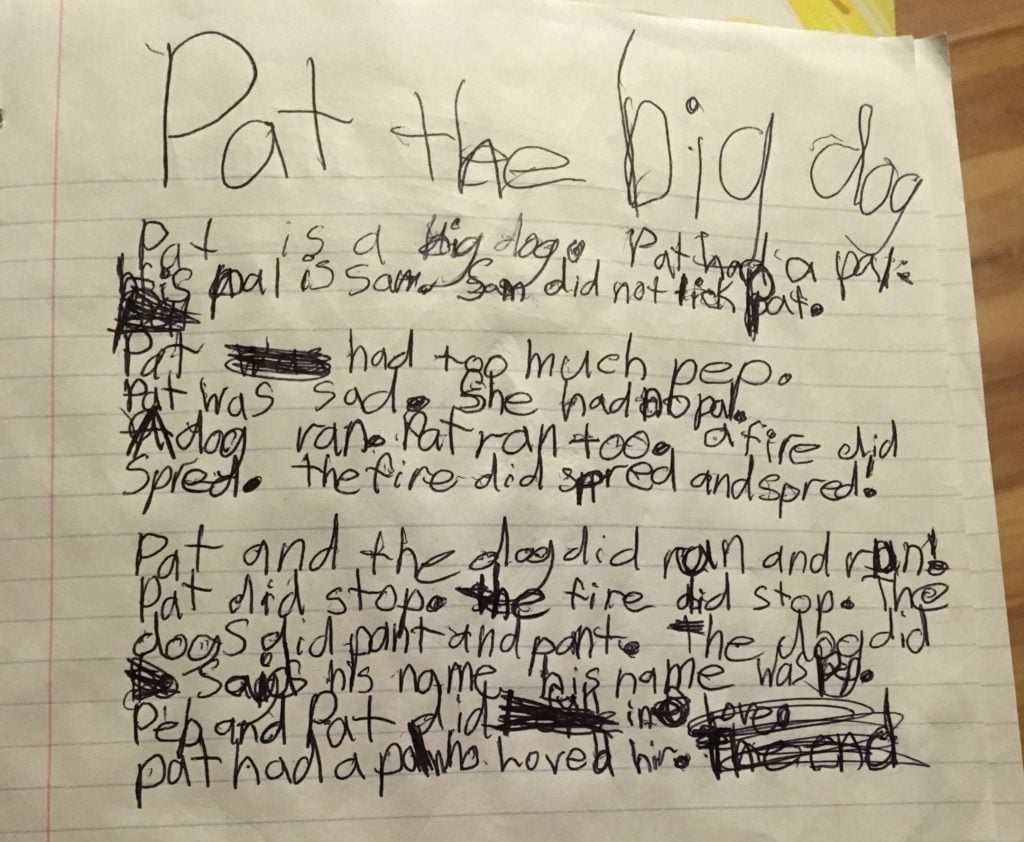
- When reading, the child with dyslexia may put letters in the wrong order, reading felt as left, act as cat, reserve as reverse, expect as except.
- They may put syllables in the wrong order, reading animal as aminal, enemy as emeny.
- They may put words in the wrong order, reading are there for there are.
- They may write letters in the wrong order, spelling Simon as Siomn, time as tiem, child as chidl.
- They may omit letters, i.e., reading or writing cat for cart, wet for went, sing for string.
.
Difficulty with the little words
A frequent comment made by parents of children struggling with their reading is, “He (or she) is so careless, he gets the big difficult words but keeps making silly mistakes on all the little ones.” Certainly, the poor reader gets stuck on difficult words, but many do seem to make things worse by making mistakes on simple words they should be able to manage — like ‘if,’ ‘to,’ ‘and.’
The following are indications of problems with the little words:
- Misreads little words, such as a for and, the for a, from for for, then for there, were for with.
- Omits or reads twice little words like the, and, but, and in.
- Adds little words which do not appear in the text.
.
It is important to note that this is extremely common and not a sign that a child is careless or lazy.
Guesses wildly at words
A child with severe dyslexia may make up a story based on the illustrations, which bears no relation to the text. They may also guess wildly at words regardless of whether they make sense or not.
They may spell bizarrely, for example, substance may be spelled ‘sepedns,’ last spelled ‘lenaka,’ about spelled ‘chehat,’ may spelled ‘mook,’ did spelled ‘don,’ or to spelled ‘anianiwe.’ These words bear little, if any, relation to the sounds in the words. Below is an example of bizarre spelling (Miles & Miles, Help for Dyslexic Children):

Poor reading comprehension
Decoding and fluency are keys to reading comprehension. Children with dyslexia may add extra words to sentences, omit words in sentences, misread words, conjugate verbs improperly, and make a variety of other reading mistakes that cause them to have a poor understanding of what they are reading. When these reading accuracy issues are multiplied over an entire passage or chapter, the dyslexic child is left knowing only bits and pieces of what they just read.
Another element that causes the dyslexic child to struggle with reading comprehension is poor vocabulary. Due to their reading struggles, they often do not acquire a solid vocabulary base at the typical ages other children do. As a result, they may not understand what they are reading, even if they can decode the words.
What are the early warning signs of dyslexia?
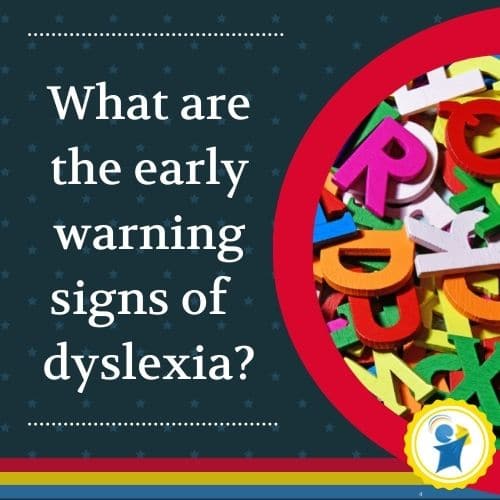
Signs of dyslexia can be difficult to recognize before a child enters school, but some early clues may indicate a problem. Signs that a young child may be at risk of dyslexia include:
Late at talking
Research has revealed a dramatic link between the abnormal development of spoken language and dyslexia. In several longitudinal studies, children with preschool speech or language impairments have been found to remain at risk for developing reading disabilities at older ages (Scarborough, 2005).
A study by Valtin, based on one hundred pairs of dyslexic and typical children, found indications of backwardness in speech development among children with dyslexia. According to Hornsby, about 60 percent of dyslexic students were late talkers.
By five, a child should have acquired basic language, and only the complexity of usage and vocabulary will improve with the years. If a child still has a speech defect, however mild, or uses immature grammatical structure in their sentences when they start school, this should alert parents and teachers to future problems with reading and writing.
Trouble with nursery rhymes
Children at risk for dyslexia may have a hard time learning nursery rhymes or song lyrics that rhyme. Nursery rhymes are important for young children because they help develop an ear for language.
Bryant et al. found a strong relationship between early knowledge of nursery rhymes at age three and success in reading and spelling at age six, even after differences in social background, IQ, and the children’s phonological skills at the start of the project were taken into account. The researchers concluded that knowledge of nursery rhymes enhances children’s phonological sensitivity, which in turn helps them to learn to read.
Late at walking
Twenty percent of dyslexic students were late walkers, according to Hornsby. Children usually take their first uncertain steps around twelve to fifteen months of age and walk well enough by eighteen months to no longer have to think about it – the activity has become automatic. If a child is not walking by eighteen months, there may be cause for concern.
Clumsy and accident-prone
Children with dyslexia are popularly thought of as clumsy and accident-prone, but while some dyslexic children are not well coordinated, many do brilliantly at sports. Clumsiness is less of a significant early pointer as late talking or even late walking. However, it is as well to bear it in mind.
If one’s child is poorly coordinated, sports like trampolining, judo, and swimming can help build up their confidence in their physical abilities and usually improve their overall coordination.
What are the risk factors for dyslexia?
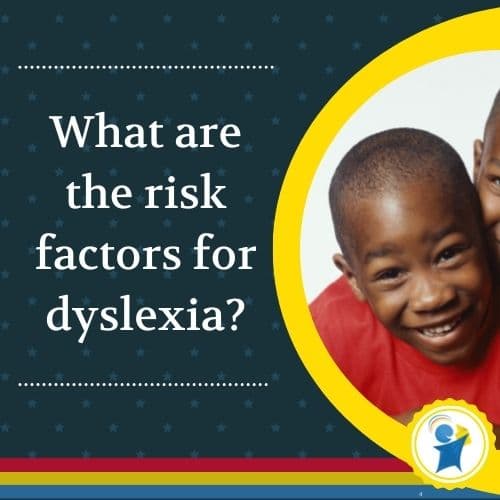
Risk factors increase the chance of developing a disease, disorder, or condition. Below are the risk factors associated with dyslexia:
Heredity
There is a large body of research on children at risk due to a family history of dyslexia. The prevalence rate for dyslexia in the general English-speaking population is between 5 and 17%. However, the rate of reading-related skill deficits (e.g., word reading, orthographic coding, phonological decoding, and phoneme awareness), based on familial risk studies, is between 35 and 40%.
Recurring ear infections
Frequent colds or ear infections in the first three years of life can impair hearing, depriving the developing brain of all-important language exercise time. Also known as “glue ear” and otitis media, these ear infections are known to cause dyslexia.
Over a period of eight years, Peer (2002) collected a sample of 1,000 children and adults referred for assessment due to identified difficulties along the dyslexia continuum. Of these, 703 had experienced severe bouts of glue ear, and 297 had not.
Left-handedness
In western societies, about 90% of the adult population are right-handed, with the remaining 10% being variably identified as left-handed, ambidextrous, or ambiguously-handed.
Koufaki and Papadatou-Pastou medically reviewed 44 studies and confirmed the statistically significant increase in non-right-handedness among people with dyslexia compared with non-dyslexics. Their study supports the theory that specific language-associated brain function is not adequately lateralized to the left hemisphere in people with dyslexia.
Overcoming the symptoms of dyslexia
Edublox specializes in educational interventions that make children smarter, help them learn and read faster, and do math easily. Our programs enable learners to overcome reading difficulties and other learning obstacles, assisting them to become life-long learners and empowering them to realize their highest educational goals.
Watch our playlist of customer reviews and experience how Edublox training and tutoring help overcome dyslexia signs and symptoms. Learn more about our approach to dyslexia treatment and book a free consultation to discuss your child’s learning needs. We cater to a variety of dyslexia types.
Authored by Sue du Plessis (B.A. Hons Psychology; B.D.), a reading specialist with 30+ years of experience in learning disabilities.
Medically reviewed by Dr. Zelda Strydom (MBChB).
